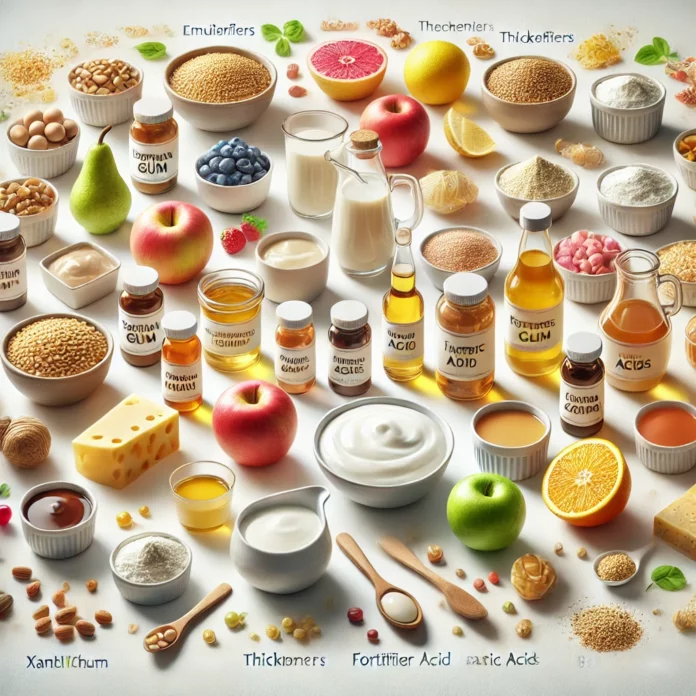
The food ingredients industry relies on a diverse range of additives to ensure product quality, enhance functionality, and meet consumer demands for taste, appearance, and nutrition. Here’s an in-depth look at the key categories of ingredients shaping the modern food industry.
1. Preservatives
Preservatives are essential for extending the shelf life of food products by preventing spoilage and microbial growth. Popular options include:
- Sodium Benzoate: Common in acidic foods like soft drinks and salad dressings, it inhibits the growth of mold and bacteria.
- Potassium Sorbate: Widely used in dairy and baked goods, it is a versatile, odorless preservative.
- Calcium Propionate: Found in bread and other baked goods, it prevents mold growth without affecting taste.
- Natural Alternatives: Ingredients like rosemary extract and vinegar are gaining traction due to clean-label trends.
2. Emulsifiers
Emulsifiers help blend oil and water in food products, ensuring consistent texture and appearance. Leading options include:
- Lecithin: Derived from soy or sunflower, it’s used in chocolate, baked goods, and margarine.
- Mono- and Diglycerides: Common in ice cream and bakery items, they improve texture and extend shelf life.
- Polysorbates: These are frequently found in whipped toppings and dressings, enhancing stability.
- Natural Emulsifiers: Ingredients like guar gum and mustard are gaining popularity as clean-label alternatives.
3. Thickeners
Thickeners improve the viscosity and texture of food products, contributing to their mouthfeel and stability. Popular thickeners include:
- Xanthan Gum: A staple in sauces, dressings, and gluten-free baking, it provides thickening and stabilization.
- Guar Gum: Derived from guar beans, it’s used in dairy products and baked goods.
- Pectin: Common in jams and jellies, it thickens and gels foods naturally.
- Carrageenan: Extracted from seaweed, it’s a common thickener in dairy and plant-based beverages.
4. Fortifiers
Fortification adds essential nutrients to food, enhancing its nutritional value. Popular fortifiers include:
- Calcium Carbonate: Used in plant-based milks and juices, it enhances calcium content.
- Iron Sulfate: A key fortifier in bread and cereal, combating iron deficiency.
- Vitamin D: Commonly added to dairy and plant-based products to promote bone health.
- Omega-3 Fatty Acids: Found in fortified eggs, milk, and bread, catering to heart-conscious consumers.
5. Acids
Acids enhance flavor, act as preservatives, and regulate pH levels in food products. Key acids include:
- Citric Acid: Derived from citrus fruits, it’s a versatile acid used in beverages, candies, and preserves.
- Lactic Acid: Found in fermented foods and used as a preservative in meats and dairy.
- Acetic Acid (Vinegar): Adds tanginess to dressings and sauces while acting as a natural preservative.
- Malic Acid: Common in candies and beverages, providing a tart flavor profile.
6. Food Colors
Food colors enhance the visual appeal of products, influencing consumer perception. Popular food colors include:
- Carmine: A natural red color derived from cochineal insects, used in candies and beverages.
- Beta-Carotene: Provides a yellow-orange hue and is sourced from carrots or sweet potatoes.
- Anthocyanins: Natural pigments giving blue, purple, and red shades, found in berries and grapes.
- Synthetic Colors: FD&C Red #40 and Blue #1 remain common but are facing scrutiny amid clean-label trends.
- Plant-Based Colors: Spirulina, turmeric, and beetroot extracts are growing in demand for natural coloring.
Conclusion
From ensuring product safety and stability to meeting consumer demands for nutrition and natural ingredients, preservatives, emulsifiers, thickeners, fortifiers, acids, and food colors are indispensable in the food industry. Companies are increasingly exploring natural and sustainable alternatives to meet the clean-label movement while maintaining the functionality and appeal of food products.



